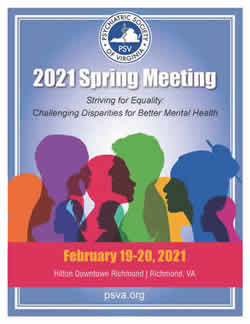Winter 2020 Issue |
|
Meeting Reviews
Fall Meeting Breakout Session Summary
Benzodiazepines: Balancing the Evidence for Safety and Efficacy
By Stephanie Peglow, DO, MPH and Dylan Golomb, MD
Benzodiazepines often place clinicians in difficult situations where balancing patient safety and rapport are seemingly at odds. Our presentation’s goal was to explore the use of benzodiazepines, the risks and benefits of their use, how they effect clinician practice in modern medicine, and how clinicians can approach benzodiazepine cessation if that is deemed most appropriate.
Benzos have a long history of efficacy and with it a long history detailing their risks. Barbiturates such as barbitol and phenobarbital revolutionized medicine when sedation was required. The launch of meprobamate in 1955 and its use and popularity in media led to the normalization of taking a medicine for “everyday ills.” The introduction of chlordiazepoxide in 1960 as the first benzo eased the perceived risks of sedatives due to the decreased risk of respiratory depression. Diazepam quickly became the top-selling psychotropic drug in the 1970’s, and benzos accounted for an estimated 1/3 prescriptions filled in the US during this time.
During this same time media portrayal was not only positive. A hit Rolling Stones song “Mother’s Little Helper” in 1966 rose to #8 on the Billboard Hot 100 the same year and describes the dependence of housewives on benzos such as diazepam “though she’s not really ill” referring to its use for everyday symptoms. More modern media portrayals include Eminem’s song “My Mom” which revolves around diazepam use and was released on his Billboard #1 album “Relapse” which was centered around substance use, sobriety, and relapse. Even more recent is a rapper named “Lil Xan” who is named as a reference to Xanax and who suffered from benzo dependence and addiction, and reportedly is now an advocate for benzo avoidance and cessation when possible after achieving sobriety.
Benzos continue to be widely prescribed. The prevalence of benzo use in the general population is 5% with women being prescribed benzos twice as often as men. Individuals prescribed opioids are more likely to be prescribed a benzo despite the black box warning for their concomitant use. Alprazolam, clonazepam, and lorazepam are among the 10 most commonly prescribed psychotropics in the US. More than 1/12 of adults over 65 were prescribed a benzo with the past year, and 1/3 of benzo use long term (>6 months) is in older adults.
Efficacy often appears limited to short term use. Benzos increased sleep duration without any change in sleep latency, however only 77% patients respond initially, less than half remit, and rebound insomnia can occur within a couple weeks of therapy. For anxiety, benzos demonstrated better efficacy and fewer side effects, however long term efficacy has limited studies though meta-analysis comparing antidepressants to benzos showed compared effectiveness, tolerability, and rates of discontinuation. When comparing benzos to placebo there was comparable effectiveness though with lower rates of discontinuation with benzos. Benzo use is associated with higher risk of occupational injuries, though underlying conditions may contribute. They are ineffective for PTSD treatment and prevention and are associated with increased risk of developing PTSD after a trauma, increased severity, and worse therapy outcomes.
In the elderly there is limited evidence for insomnia, anxiety, or behavioral disturbance, and in some exists that it may worsen behavior. Use of benzos in the elderly is associated with a 3x increase in falls, 5x increase in acute cognitive effects, and with increased rates of fractures and MVAs. Overall their use is 2x more likely to be associated with an adverse effect than to improve sleep. The BEERS criteria lists all benzos as potentially inappropriate in elderly. Ultimately benzo use in the elderly is out of proportion to their efficacy and safety profile.
Although most patients take benzos as prescribed, approximately 2-18% of Americans have misused sedatives for non-medical use, and 10% would meet criteria for benzodiazepine use disorder. The highest risk groups are those with comorbid alcohol use disorder or antisocial personality disorder. The rate of deaths involving benzos over the past two decades has increased nearly tenfold, and the risk of death is nearly tenfold higher for those also prescribed an opioid. Concurrent with the increase in opioid prescriptions, there has been an increase in benzo prescriptions and a roughly 3x increase in lorazepam equivalents prescribed. In 9/2020 the FDA added a black box warning to benzos as a class due to their risk of dependence, misuse, addiction, and withdrawal. Third party venues for obtaining benzos have increased in popularity, including online sale of “research chemical” benzos.
As psychiatrists this data emphasizes the need to educate other clinicians who prescribe benzos, and to set an example by educating patients and practicing safe prescribing ourselves. Patients should be educated of the risk and benefits of benzo use compared to safer alternatives. Lifestyle changes should be encouraged. Alternatives such as SSRIs, neuroleptics, and safer sleep aids should be discussed with patients. Tapering benzos to their lowest efficacious dose or to cessation should be discussed with patients. Take a detailed psychiatric inventory to include symptoms as they relate to benzo initiation and dose changes as well as other substance use. For patients who have been on benzos for months or years, clinicians should consider a long, slow taper such as outlined in sources such as the Ashton Manual. Tapers should be tailored to patient response and should address underlying symptoms that led to benzo use in the first place. Supportive and motivational therapy may be helpful during this time, though realize that benzo use may limit therapy participation, particularly in more involved therapies. There are a growing number of online groups for patients attempting to taper benzos. I would use caution in recommending them proactively as many have become and echo chamber for anti-psychiatry sentiment. We encourage that you approach patients experiencing a difficult taper with understanding, allowing their symptoms to help guide the rate of their taper, which may help foster or regain trust with the psychiatric community.
Ultimately, safe deprescribing is best avoided by practicing safe prescribing in the first place. Safe prescribing guidelines suggest setting expectations with patients about short term use and to limit use to two weeks, such as for augmentation during SSRI initiation or for short term crises. They are not recommended for patients with current or past substance use disorders. NICE guidelines suggest benzos be used 3rd or 4th line for insomnia. Antidepressants are first like for GAD, and the only guidelines suggesting benzos are appropriate as first line are 2009 APA guidelines for panic disorder in absence of co-occuring mood disorder. Avoid benzos in patients with PTSD, chronic respiratory diseases, those with other CNS depressants, substance use disorders, history of TBI, the elderly, and those with dementia. When used, limit their use to the short term.
YOUR NEWSLETTER IS NOW AVAILABLE ON YOUR SMARTPHONE AND TABLET!
JOIN PSV TODAY!
PLAN NOW!
PSV 2021
SPRING MEETING
February 19-20, 2021
Hilton
Downtown Richmond
Richmond, VA
REGISTRATION IS OPEN!
CLICK HERE!
APA Find a Psychiatrist
Are you accepting new patients?
Opt into APA’s “Find A Psychiatrist” database. To view the functionality or opt-in,
CLICK HERE
FYI: A link for this option has been added to the PSV website. Select the “About” button and then “Find a Psychiatrist” from the drop down.




